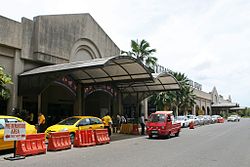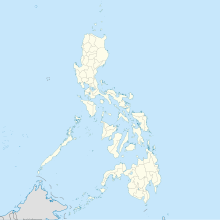Mactan International Airport
|
Mactan–Cebu International Airport Tugpahanang Pangkalibutan sa Mactan–Sugbo (Cebuano) Paliparang Pandaigdig ng Mactan–Cebu (Filipino) |
|||||||||||
|---|---|---|---|---|---|---|---|---|---|---|---|
 |
|||||||||||

Exterior of Mactan–Cebu International Airport
|
|||||||||||
| Summary | |||||||||||
| Airport type | Public | ||||||||||
| Owner | Mactan-Cebu International Airport Authority | ||||||||||
| Operator | GMR-Megawide Cebu Airport Corporation | ||||||||||
| Serves | Metro Cebu and Central Visayas | ||||||||||
| Location | Lapu-Lapu Airport Road, Barangay Ibo, Lapu-Lapu City, Metro Cebu, Central Visayas | ||||||||||
| Hub for | |||||||||||
| Built | 1956 | ||||||||||
| Elevation AMSL | 9 m / 31 ft | ||||||||||
| Coordinates | 10°18′26″N 123°58′44″E / 10.30722°N 123.97889°ECoordinates: 10°18′26″N 123°58′44″E / 10.30722°N 123.97889°E | ||||||||||
| Website | www |
||||||||||
| Map | |||||||||||
| Location in the Philippines | |||||||||||
| Runways | |||||||||||
|
|||||||||||
| Statistics (2016) | |||||||||||
|
|||||||||||
|
2016 MCIAA Statistics
|
|||||||||||
| Passengers | 8,830,638 |
|---|---|
| Aircraft movements | 71,543 |
| Cargo (in kg) | 66,925,835 |
Mactan–Cebu International Airport (Cebuano: Tugpahanang Pangkalibutan sa Mactan–Sugbo, Filipino: Paliparang Pandaigdig ng Mactan–Cebu) (IATA: CEB, ICAO: RPVM) located in Central Visayas region, is the second busiest airport of the Philippines. It is located in Lapu-Lapu City on Mactan Island, part of Metro Cebu. The airport is managed by the Mactan–Cebu International Airport Authority. It covers an area of 797 hectares (1,970 acres).
It has a single 3,300-meter (10,800 ft) runway that was built by the United States in 1956 as an emergency airport for Strategic Air Command bombers and was known as the Mactan Air Base. The runway is complemented by a full-length taxiway that it shares with the current Mactan Air Base of the Philippine Air Force.
Mactan–Cebu International Airport was chosen as the most viable location for the world's largest aircraft, the Antonov An-225 Mriya, to safely land when considering the combination of onward land transportation, sea freight, and airport capacity. The arrival of the aircraft in the airport marked the very first time that the aircraft landed in the Philippines.
The runway was built by the United States Air Force in 1956 as an emergency airport for Strategic Air Command bombers and it was known as the Mactan Air Base. It remained a spartan outpost until the Vietnam War in the 1960s when it became a base for a C-130 unit of the U.S. Air Force.
...
Wikipedia

